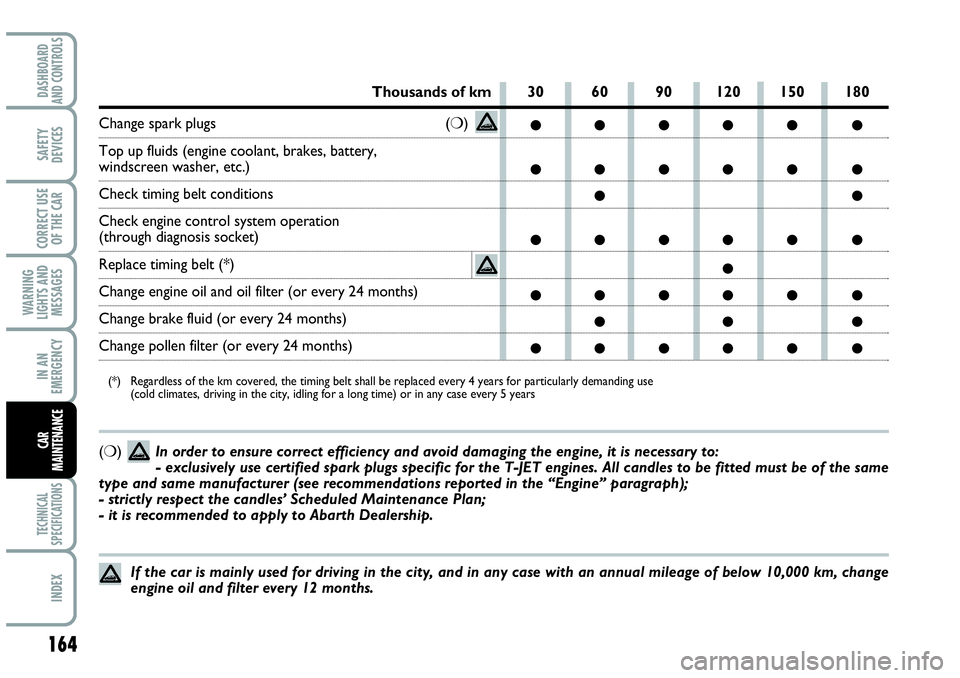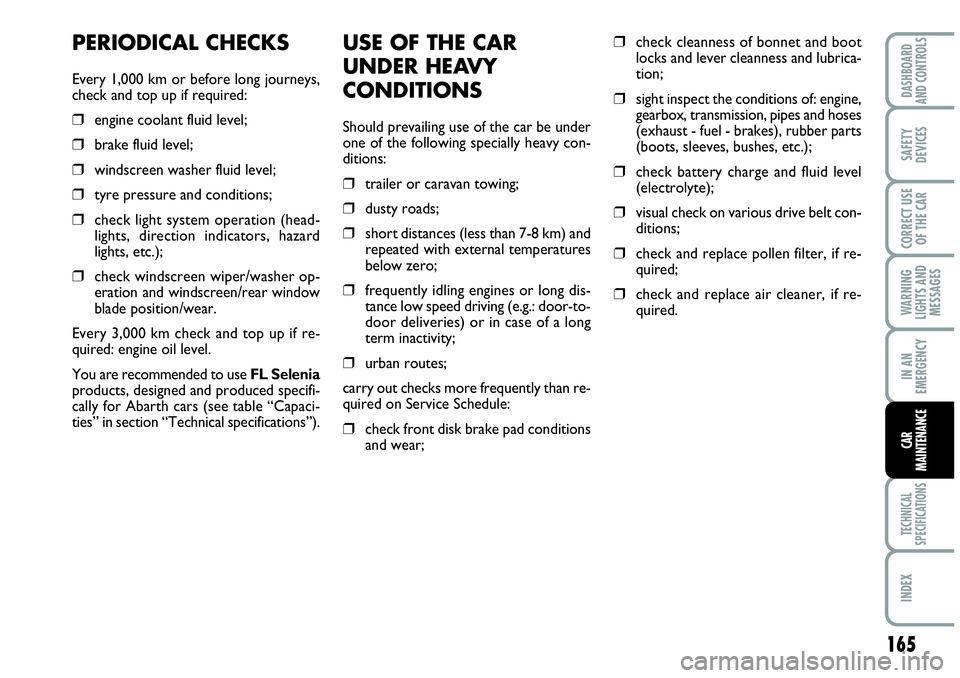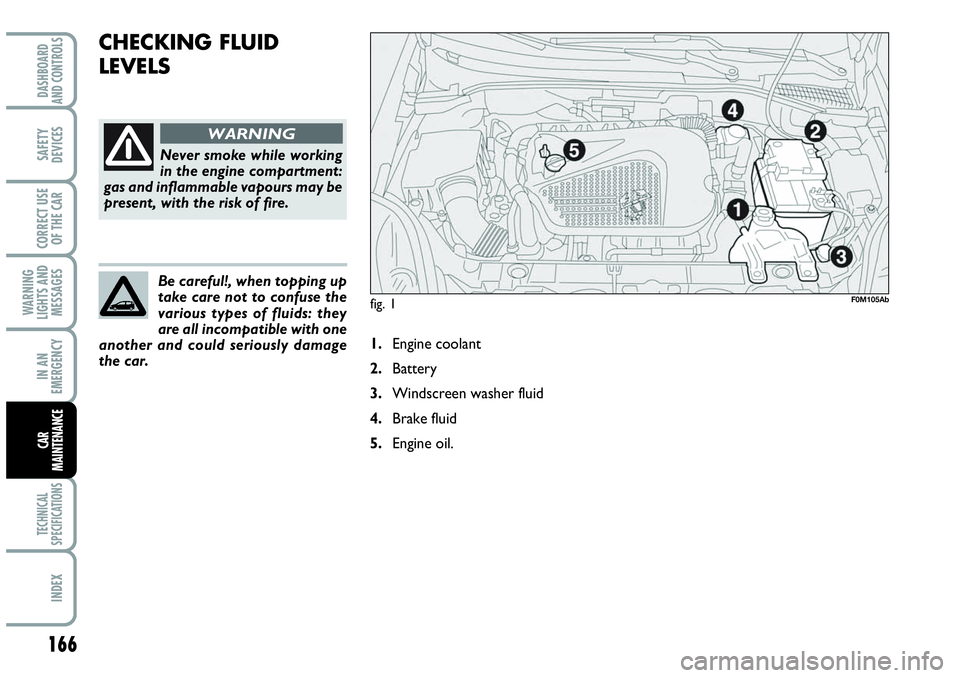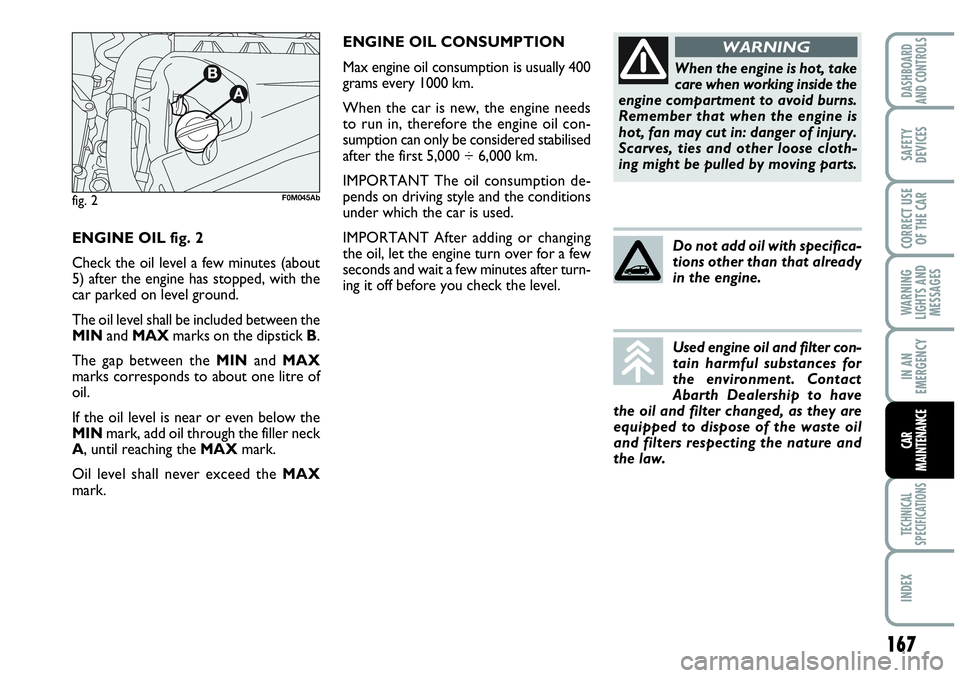technical specifications Abarth Grande Punto 2010 Owner handbook (in English)
[x] Cancel search | Manufacturer: ABARTH, Model Year: 2010, Model line: Grande Punto, Model: Abarth Grande Punto 2010Pages: 207, PDF Size: 3.01 MB
Page 166 of 207

(❍) In order to ensure correct efficiency and avoid damaging the engine, it is necessary to:
- exclusively use certified spark plugs specific for the T-JET engines. All candles to be fitted must be of the same
type and same manufacturer (see recommendations reported in the “Engine” paragraph);
- strictly respect the candles’ Scheduled Maintenance Plan;
- it is recommended to apply to Abarth Dealership.
164
WARNING
LIGHTS AND
MESSAGES
TECHNICAL
SPECIFICATIONS
INDEX
DASHBOARD
AND CONTROLS
SAFETY
DEVICES
CORRECT USE
OF THE CAR
IN AN
EMERGENCY
CAR
MAINTENANCE
30 60 90 120 150 180
●●●●● ●
●●●●● ●
●●
●●●●● ●
●
●●●●● ●
●● ●
●●●●● ●
Thousands of km
Change spark plugs (❍)
Top up fluids (engine coolant, brakes, battery,
windscreen washer, etc.)
Check timing belt conditions
Check engine control system operation
(through diagnosis socket)
Replace timing belt (*)
Change engine oil and oil filter (or every 24 months)
Change brake fluid (or every 24 months)
Change pollen filter (or every 24 months)
(*) Regardless of the km covered, the timing belt shall be replaced every 4 years for particularly demanding use
(cold climates, driving in the city, idling for a long time) or in any case every 5 years
If the car is mainly used for driving in the city, and in any case with an annual mileage of below 10,000 km, change
engine oil and filter every 12 months.
Page 167 of 207

USE OF THE CAR
UNDER HEAVY
CONDITIONS
Should prevailing use of the car be under
one of the following specially heavy con-
ditions:
❒trailer or caravan towing;
❒dusty roads;
❒short distances (less than 7-8 km) and
repeated with external temperatures
below zero;
❒frequently idling engines or long dis-
tance low speed driving (e.g.: door-to-
door deliveries) or in case of a long
term inactivity;
❒urban routes;
carry out checks more frequently than re-
quired on Service Schedule:
❒check front disk brake pad conditions
and wear;
❒check cleanness of bonnet and boot
locks and lever cleanness and lubrica-
tion;
❒sight inspect the conditions of: engine,
gearbox, transmission, pipes and hoses
(exhaust - fuel - brakes), rubber parts
(boots, sleeves, bushes, etc.);
❒check battery charge and fluid level
(electrolyte);
❒visual check on various drive belt con-
ditions;
❒check and replace pollen filter, if re-
quired;
❒check and replace air cleaner, if re-
quired.
PERIODICAL CHECKS
Every 1,000 km or before long journeys,
check and top up if required:
❒engine coolant fluid level;
❒brake fluid level;
❒windscreen washer fluid level;
❒tyre pressure and conditions;
❒check light system operation (head-
lights, direction indicators, hazard
lights, etc.);
❒check windscreen wiper/washer op-
eration and windscreen/rear window
blade position/wear.
Every 3,000 km check and top up if re-
quired: engine oil level.
You are recommended to use FL Selenia
products, designed and produced specifi-
cally for Abarth cars (see table “Capaci-
ties” in section “Technical specifications”).
165
WARNING
LIGHTS AND
MESSAGES
TECHNICAL
SPECIFICATIONS
INDEX
DASHBOARD
AND CONTROLS
SAFETY
DEVICES
CORRECT USE
OF THE CAR
IN AN
EMERGENCY
CAR
MAINTENANCE
Page 168 of 207

166
WARNING
LIGHTS AND
MESSAGES
TECHNICAL
SPECIFICATIONS
INDEX
DASHBOARD
AND CONTROLS
SAFETY
DEVICES
CORRECT USE
OF THE CAR
IN AN
EMERGENCY
CAR
MAINTENANCE
CHECKING FLUID
LEVELS
Never smoke while working
in the engine compartment:
gas and inflammable vapours may be
present, with the risk of fire.
WARNING
Be careful!, when topping up
take care not to confuse the
various types of fluids: they
are all incompatible with one
another and could seriously damage
the car.
fig. 1
1.Engine coolant
2.Battery
3.Windscreen washer fluid
4.Brake fluid
5.Engine oil.
F0M105Ab
Page 169 of 207

ENGINE OIL CONSUMPTION
Max engine oil consumption is usually 400
grams every 1000 km.
When the car is new, the engine needs
to run in, therefore the engine oil con-
sumption can only be considered stabilised
after the first 5,000 ÷ 6,000 km.
IMPORTANT The oil consumption de-
pends on driving style and the conditions
under which the car is used.
IMPORTANT After adding or changing
the oil, let the engine turn over for a few
seconds and wait a few minutes after turn-
ing it off before you check the level. ENGINE OIL fig. 2
Check the oil level a few minutes (about
5) after the engine has stopped, with the
car parked on level ground.
The oil level shall be included between the
MINand MAXmarks on the dipstick B.
The gap between the MINand MAX
marks corresponds to about one litre of
oil.
If the oil level is near or even below the
MINmark, add oil through the filler neck
A, until reaching the MAXmark.
Oil level shall never exceed the MAX
mark.
When the engine is hot, take
care when working inside the
engine compartment to avoid burns.
Remember that when the engine is
hot, fan may cut in: danger of injury.
Scarves, ties and other loose cloth-
ing might be pulled by moving parts.
WARNING
167
WARNING
LIGHTS AND
MESSAGES
TECHNICAL
SPECIFICATIONS
INDEX
DASHBOARD
AND CONTROLS
SAFETY
DEVICES
CORRECT USE
OF THE CAR
IN AN
EMERGENCY
CAR
MAINTENANCE
fig. 2F0M045Ab
Do not add oil with specifica-
tions other than that already
in the engine.
Used engine oil and filter con-
tain harmful substances for
the environment. Contact
Abarth Dealership to have
the oil and filter changed, as they are
equipped to dispose of the waste oil
and filters respecting the nature and
the law.
Page 170 of 207

168
WARNING
LIGHTS AND
MESSAGES
TECHNICAL
SPECIFICATIONS
INDEX
DASHBOARD
AND CONTROLS
SAFETY
DEVICES
CORRECT USE
OF THE CAR
IN AN
EMERGENCY
CAR
MAINTENANCE
WINDSCREEN/REAR WINDOW
WASHER FLUID fig. 4
To top up, remove the cap A.
Pour a mixture of water and TUTELA
PROFESSIONAL SC35, in the follow-
ing concentrations:
30% TUTELA PROFESSIONAL
SC35and 70% water in summer.
50% TUTELA PROFESSIONAL
SC35and 50% water in winter.
In case of temperatures below –20°C, use
undiluted TUTELA PROFESSIONAL
SC35fluid.
Check level through the reservoir. ENGINE COOLANT fig. 3
The coolant level shall be checked with
cold engine and shall be within the MIN
and MAXmarks on the tank.
If the level is low, pour slowly a mixture
of 50% distilled water and 50%
PARAFLU UP of the FL Selenia Group
through the filler neck Auntil the level
reaches MAX.
A 50-50 mixture of PARAFLU UPand
distilled water gives freeze protection to
–35°C.
For particularly hard climate conditions,
we recommend use of a 60%PARAFLU
UP and 40% demineralized water mix-
ture. The engine cooling system us-
es protective antifreeze fluid
PARAFLU UP. Use the same
fluid type as that already in
the cooling system when topping up.
PARAFLU UP fluid cannot be mixed
with any other type of fluid. Should it
happen, under no circumstances start
the engine; contact a Fiat Dealership.
The cooling system is pres-
surised. If necessary, replace
the cap only with another genuine
one, otherwise system efficiency
could be compromised. Do not re-
move the reservoir cap when the en-
gine is hot: you risk scalding yourself.
WARNING
fig. 3F0M0152mfig. 4F0M0154m
Page 171 of 207

169
WARNING
LIGHTS AND
MESSAGES
TECHNICAL
SPECIFICATIONS
INDEX
DASHBOARD
AND CONTROLS
SAFETY
DEVICES
CORRECT USE
OF THE CAR
IN AN
EMERGENCY
CAR
MAINTENANCE
Do not travel with the wind-
screen washer reservoir emp-
ty: the windscreen washer is funda-
mental for improving visibility.
WARNING
Certain commercial addi-
tives for windscreen washers
are inflammable. The engine com-
partment contains hot components
which may set it on fire.
WARNING
BRAKE FLUID fig. 5
Unscrew cap A: check that the fluid level
in the reservoir is at maximum.
Fluid level in the reservoir shall not exceed
the MAXmark.
If fluid has to be added, it is suggested to
use the brake fluid in table “Fluids and lu-
bricants” (see chapter “Technical charac-
teristics”).
fig. 5F0M0155m
NOTE Clean accurately the tank cap A
and the surrounding surface.
At plug opening, pay maximum attention
in order to prevent any impurities from
entering the tank.
For topping up, always use a funnel with
integrated filter with mesh equal to or
lower than 0.12 mm.
IMPORTANT Brake fluid absorbs mois-
ture, for this reason, if the vehicle is main-
ly used in areas with a high degree of at-
mospheric humidity, the fluid should be
replaced at more frequent intervals than
specified in the “Service schedule”.
Page 172 of 207

170
WARNING
LIGHTS AND
MESSAGES
TECHNICAL
SPECIFICATIONS
INDEX
DASHBOARD
AND CONTROLS
SAFETY
DEVICES
CORRECT USE
OF THE CAR
IN AN
EMERGENCY
CAR
MAINTENANCE
AIR FILTER
Air cleaner replacement shall be carried
out at Abarth Dealership. Make sure that the highly
corrosive brake fluid does not
drip onto the paintwork; if it
does, wash it off immediate-
ly with water.
Brake fluid is poisonous and
highly corrosive. In the event
of accidental contact, wash the parts
involved immediately with neutral
soap and water, then rinse thor-
oughly. Call the doctor immediately
if the fluid is swallowed.
WARNING
The symbol πon the con-
tainer indicates synthetic
brake fluid, distinguishing it from the
mineral kind. Using mineral fluids ir-
reversibly damages the special brak-
ing system rubber seals.
WARNING
POLLEN FILTER
Pollen filter replacement shall be carried
out at Abarth Dealership.
Page 173 of 207

171
WARNING
LIGHTS AND
MESSAGES
TECHNICAL
SPECIFICATIONS
INDEX
DASHBOARD
AND CONTROLS
SAFETY
DEVICES
CORRECT USE
OF THE CAR
IN AN
EMERGENCY
CAR
MAINTENANCE
BATTERY
The car fits a low-maintenance battery: no
top-ups with distilled water are needed in
normal conditions of use.
INSPECTING THE CHARGE
AND THE ELECTROLYTE LEVEL
Inspection operations must be carried out
by specialised personnel, following the
prescriptions contained in the Use and
maintenance booklet. Any top-up opera-
tions must be carried out by specialised
personnel and by Abarth Dealership.Running the battery with an
excessively low liquid level
will damage the battery beyond re-
pair and even cause an explosion.
WARNINGIncorrect assembly of electric
and electronic devices may
cause severe damage to your
car. Go to a Abarth Dealer-
ship if you want to install accessories
(alarms, mobile phone, etc.): they will
suggest the most suitable devices and
advise you if a higher capacity battery
needs to be installed.
Batteries contain substances
that can be very dangerous
for the environment. t is ad-
visable to have the battery
changed by a Abarth Dealership where
it will be disposed of according to the
law.
Page 174 of 207

172
WARNING
LIGHTS AND
MESSAGES
TECHNICAL
SPECIFICATIONS
INDEX
DASHBOARD
AND CONTROLS
SAFETY
DEVICES
CORRECT USE
OF THE CAR
IN AN
EMERGENCY
CAR
MAINTENANCE
IMPORTANT If the charge level remains
for a long time under 50%, the battery is
damaged by sulphation, reducing its ca-
pacity and starting attitude.
The battery will also be more at risk of
freezing (e.g. already at -10°C). Refer to
the paragraph “Car inactivity” in “Starting
and driving” if the car is left parked for a
long time.
If after buying the car, you want to install
electric accessories which require per-
manent electric supply (alarm, etc.) con-
tact Abarth Dealership whose qualified
personnel, in addition to suggesting the
most suitable devices, will evaluate the
overall electric absorption, checking
whether the car’s electric system is capa-
ble of withstanding the load required, or
whether it should be integrated with a
more powerful battery.
Since these devices continue absorbing en-
ergy even when the ignition key is off, they
gradually run down the battery. USEFUL ADVICE FOR
LENGTHENING THE LIFE OF
YOUR BATTERY
To avoid draining your battery and length-
en its life, observe the following indica-
tions:
❒when you park the car, ensure the
doors, tailgate and bonnet are closed
properly;
❒switch off all lights inside the car: the
car is however equipped with a system
which switches all internal lights off au-
tomatically;
❒do not keep accessories (e.g. sound sys-
tem, hazard lights, etc.) switched on for
a long time when the engine is not run-
ning;
❒before performing any operation on the
electrical system, disconnect the bat-
tery negative cable;
❒battery terminals shall always be per-
fectly tightened.
If the vehicle must remain
unused for a long time at
very low temperature, remove the
battery and carry it to a warm place,
to avoid freezing.
WARNING
When you must perform any
operation on the battery or
near it, always protect your eyes with
the special goggles.
WARNING
Page 175 of 207

173
WARNING
LIGHTS AND
MESSAGES
TECHNICAL
SPECIFICATIONS
INDEX
DASHBOARD
AND CONTROLS
SAFETY
DEVICES
CORRECT USE
OF THE CAR
IN AN
EMERGENCY
CAR
MAINTENANCE
WHEELS AND TYRES
Check the pressure of each tyre, includ-
ing the spare, every two weeks and before
long journeys. The pressure should be
checked with the tyre rested and cold.
For the correct tyre inflation pressure, see
“Wheels” in “Technical specifications”
section.
Incorrect pressure causes abnormal tyre
wearfig. 6:
Anormal pressure: tread evenly worn.
Blow pressure: tread particularly worn
at the edges.
Chigh pressure: tread particularly worn
in the centre.
Tyres must be replaced when the tread
wears down to 1.6 mm. In any case, com-
ply with the laws in the country where the
car is being driven.
fig. 6F0M0160m
IMPORTANT NOTES
❒As far as possible, avoid sharp braking
and screech starts etc. Be careful not
to hit the kerb, potholes or other ob-
stacles hard. Driving for long stretch-
es over bumpy roads can damage the
tyres;
❒periodically check that the tyres have
no cuts in the side wall, abnormal
swelling or irregular tyre wear. If any of
these occur, have the car seen to at a
Abarth Dealership;
❒avoid overloading the car when travel-
ling: this may cause serious damage to
the wheels and tyres;
❒if a tyre is punctured, stop immediate-
ly and charge it to avoid damage to the
tyre, the rim, suspensions and steering
system;
❒tyres age even if they are not used
much. Cracks in the tread rubber are
a sign of ageing. In any case, if the tyres
have been on the car for over 6 years,
they should be checked by specialised
personnel, to see if they can still be
used. Also remember to check the
spare wheel;
❒ in the case of replacement, always fit
new tyres, avoiding those of dubious
origin;
❒ if a tyre is changed, also change the in-
flation valve;
❒to allow even wear between the front
and rear tyres, it is advisable to change
them over every 10-15 thousand kilo-
metres, keeping them on the same side
of the car so as not to reverse the di-
rection of rotation.
Remember that road holding
depends also on the correct
tyre inflating pressure.
WARNING